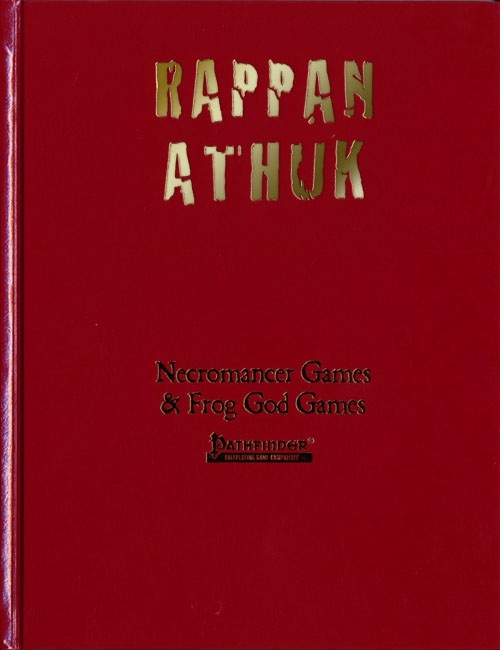
The Granddaddy of All Dungeons Returns! Rappan Athuk, the legendary mega-dungeon by Frog God Games and Necromancer Games is nothing more and nothing less than a good, old–fashioned, First Edition dungeon crawl updated for the Pathfinder Roleplaying Game. Very difficult, Rappan Athuk will truly strike fear into the hearts of the most stalwart adventurers. It offers legions of inventive traps, tricks, strange features, and monsters—many of them never before seen. It affords numerous opportunities for roleplaying, but anyone willing to brave these subterranean halls better arrive ready to rumble, or their lives will be short indeed. Many, many players have lost favored PCs delving into the depths of this dungeon, all the while giggling like children and having the time of their lives. Hundreds, if not thousands of players have combed the halls of Rappan Athuk over the years, seeking treasure and fame, making it one of the best-known dungeon locations the game has ever produced. Even players who have never entered its halls know the term: “Don’t go down the Well!” Also available for S&W and broken into multiple adventures. Also see https://paizo.com/store/byCompany/f/frogGodGames/pathfinderRPG/rappanAthuk for expansions for this product.

Irtep’s Dish is an adventure for characters from 6th to 8th level. This adventure requires the skills of a rogue or some other expert at traps, a cleric or character that can heal allies and offer beneficial bonuses to the team, a wizard or other master of the arcane arts, and a fighter to take care of “the heavy lifting.”
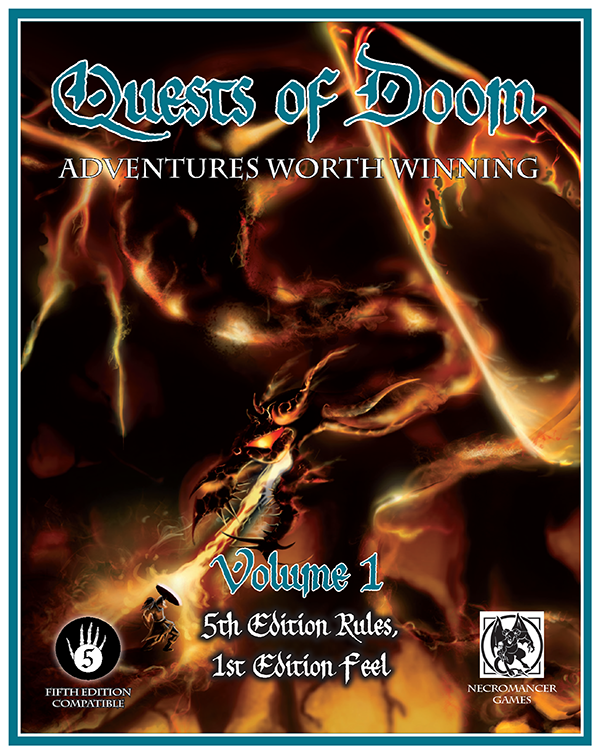
Quests of Doom Volume 1: 12 Adventures for Fifth Edition Rules, First Edition Feel! Necromancer Games is back: are you ready to rock the new edition old-school style? We put together a team of some of the best adventure-writers in RPG history to ring in the new fifth edition rules with a host of adventures you’ve never seen before (and a couple that you have, but probably didn’t survive anyway). Volume 1 of Quests of Doom contains 12 adventures in almost 200 pages, by Ed Greenwood (Emeralds of Highfang), Bill Webb (Ra’s Evil Grin, Sorcerer’s Citadel, Hidden Oasis, Pyramid of Amra, Sewers of the Underguild), Matt Finch (Hidden Oasis-Temple of Thoth), Jim Ward (Deep in the Vale), J. Collura (Noble Rot), Michael Curtis (The Dead from Above), Casey Christofferson (Ra’s Evil Grin, Sorcerer’s Citadel, Irtep’s Dish), Skip Williams(Death in Dyrgalas), and Steve Winter (Bad Moon Rising).

God of Ore is a 3rd-level adventure that takes the characters from the quiet, mountainside town of Miners’ Refuge into the heart of the Stoneheart Mountains in pursuit of a failed pilgrimage to discover a phony religious relic deep inside legendary Mithral Mountain. The dark, twisting tunnels that bore into the fabled mountain soon reveal that some mysteries are not what they first appear to be.

A Maze of Tragedy and Mystery. While investigating a mysteriously abandoned mansion, the adventurers stumble into a tangled web of kidnapping, theft and murder. From a mansion with a deadly secret to the blood-stained waves of the high seas and an ancient, cursed citadel, the adventurers face a succession of deadlier and deadlier foes, with the rescue of innocents and the recovery of fabulous treasure as their ultimate rewards. A Family Affair includes a fully-developed town setting, numerous unique NPCs and a wide range of challenging opponents.

The Hidden Oasis-Temple of Thoth brings the characters to a hidden temple of Thoth, god of knowledge, magic, and travel, where they are confronted with a force of invading extra-dimensional locust creatures and the chance to get their hands on an ancient artifact. What band of heroes could resist the challenge?

The set-up is interesting in a way – the PCs are plain folks of the Vale, everyday people, and the module begins promising, with the Thor-ordained sporty trek around the vale that inevitably results in trouble. The module, obviously, tries to chronicle the step from everyday-Joe/Jane to hero and the tidbits on culture provided are intriguing. But this, as much as I’m loathe to say it, is one of the worst modules FGG has ever released. If I didn’t know any better, I wouldn’t expect Mr. Ward’s pen at work here. Let me elaborate: The premise, is unique and hasn’t been done much recently, but it suffers from this being an adventure – to properly invest the players in the setting a closer gazetteer, nomenclature, suggested roles and origins for casting talent – all of that should have been covered. They’re not. Worse, everything here is a) clichéd and b) a non-threat in the great whole of things.

I am the Set Rahotep No man was more potent when I was amongst those dwelling in the land of Khemit. In death I am greater still! Do you not fear serpents? I am the Aepep Rahotep! Who does not tremble before the monsters of the Duat? I am one! Does your flesh not crawl at the sight of a terrible wyrm? I am the Deathwyrm Rahotep! Does your blood run cold before the face of a fiend? Know then that I am Rahotep the Fiend! Who shuns not demons? Shun me, for I am the demon Rahotep, the Red Devil. And which fool listens? That one is wise! Praise Set and the Set Rahotep, that one, and pity the rest! An Epic Adventure and Sourcebook Gary Gygax's Necropolis is a vast campaign scenario that sweeps the characters into an epic adventure across the magical desert kingdom of Khemit. From a hidden evil in a desert village, to the secrets of ancient tombs, Necropolis takes the characters on a dangerous mission to thwart the plans of an undying archpriest-wizard who would be a god! Necropolis is also a campaign sourcebook, detailing the lands of Khemit, new classes and prestige classes, new spells and more than 60 monsters unique to the desert lands. This book also details over 50 new gods and new cleric domains, allowing DMs to run extended campaigns in the desert kingdom.

For decades, Theatre Infernalis offered shocking and frightful entertainment to customers who entered its gaping demonic facade and saw a frightful portrait of the eternal torments that await all sinners. Now rumours tell of the aging and supposedly-cursed proprietor's deteriorating health and the theatre's impending sale, and the Artist's Quarter has been abuzz with those seeking one final fright with a walk through the crucible-licked walls of the infernal house of the macabre before its final curtain call. But are the theatre's smoke-and-mirrors and cheap scares hiding a truly wicked secret? What is the nature of the curse and illness that afflict the owner? And did foul and profane rites once take place between its walls that outside forces now seek to exploit? What happens when the spookshow's fun and games transform into a terrifying reality, threatening to spill forth an infernal malevolence onto the streets of the Blight?
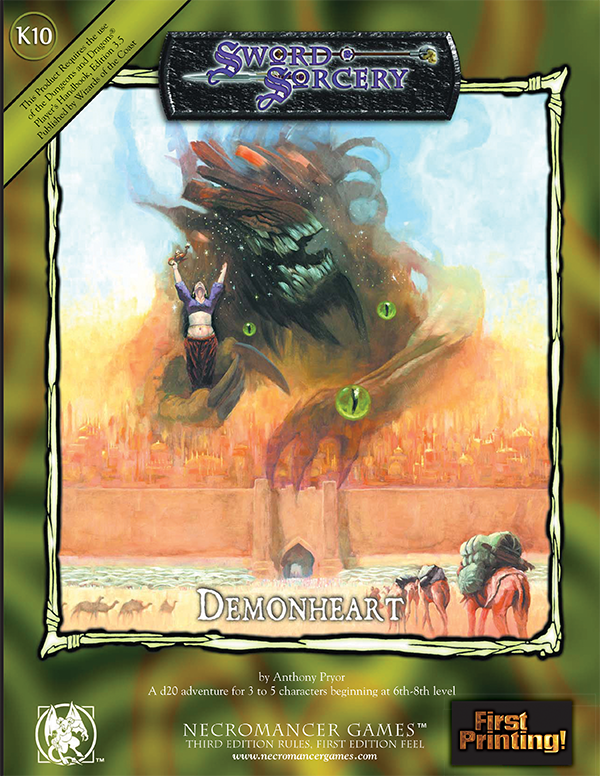
Demonheart is a D20 adventure campaign for 4-5 characters. As it is a long and fairly involved story, characters should be level 6-8 when they begin and will earn enough experience to rise to levels 10-12. Demonheart includes many opportunities for both combat and roleplaying. At least one fighter-type is required, and given the wild, frontier nature of the campaign, a ranger’s skills would be especially useful. Stealth and intrigue also favor rogue characters, while a cleric, particularly from a martial order who can fight well would find plenty of opportunity to use his or her powers against the undead and evil outsiders. Demonheart also takes place in a wilderness setting where ancient magic abounds, and the special nature skills of a druid will help the party to make friends with some of the land’s fey or wild elvish inhabitants. Sorcerers and wizards will likewise find use for their talents, but those who understand divine or druidic magic may be more important than arcanists. As this adventure involves the struggle against evil, both ancient and resurgent, the party’s overall alignment should be good, though individuals of other alignments may be tempted to use the ancient magic of the forest for their own ends, or even join with the forces of evil!
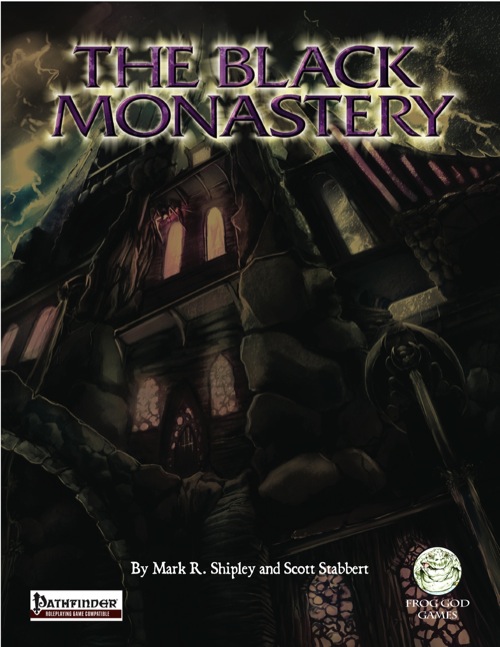
The Legend of the Black Monastery Two centuries have passed since the terrible events associated with the hideous cult known as the Black Brotherhood. Only scholars and story-tellers remember now how the kingdom was nearly laid to waste and the Black Monastery rose to grandeur and fell into haunted ruins. The Brothers first appeared as an order of benevolent priests and humble monks in black robes who followed a creed of kindness to the poor and service to the kingdom. Their rules called for humility and self denial. Other religious orders had no quarrel with their theology or their behavior. Their ranks grew as many commoners and nobles were drawn to the order by its good reputation. The first headquarters for the order was a campsite, located in a forest near the edge of the realm. The Brothers said that their poverty and dedication to service allowed them no resources for more grand accommodations. Members of the Black Brotherhood built chapels in caves or constructed small temples on common land near villages. They said that these rustic shrines allowed them to be near the people they served. Services held by the Brothers at these locations attracted large numbers of common people, who supported the Black Brotherhood with alms. Within 50 years of their first appearance, the Black Brotherhood had a number of larger temples and abbeys around the kingdom. Wealthy patrons endowed them with lands and buildings in order to buy favor and further the work of the Brothers. The lands they gained were slowly expanded as the order’s influence grew. Many merchants willed part of their fortunes to the Black Brotherhood, allowing the order to expand their work even further. The Brothers became bankers, loaning money and becoming partners in trade throughout the kingdom. Within 200 years of their founding, the order was wealthy and influential, with chapters throughout the kingdom and spreading into nearby realms. With their order well-established, the Black Brotherhood received royal permission to build a grand monastery in the hill country north of the kingdom’s center. Their abbot, a cousin of the king, asked for the royal grant of a specific hilltop called the Hill of Mornay. This hill was already crowned by ancient ruins that the monks proposed to clear away. Because it was land not wanted for agriculture, the king was happy to grant the request. He even donated money to build the monastery and encouraged others to contribute. With funds from around the realm, the Brothers completed their new monastery within a decade. It was a grand, sprawling edifice built of black stone and called the Black Monastery. From the very beginning, there were some who said that the Black Brotherhood was not what it seemed. There were always hints of corruption and moral lapses among the Brothers, but no more than any other religious order. There were some who told stories of greed, gluttony and depravity among the monks, but these tales did not weaken the order’s reputation during their early years. All of that changed with the construction of the Black Monastery. Within two decades of the Black Monastery’s completion, locals began to speak of troubling events there. Sometimes, Brothers made strange demands. They began to cheat farmers of their crops. They loaned money at ruinous rates, taking the property of anyone who could not pay. They pressured or even threatened wealthy patrons, extorting money in larger and larger amounts. Everywhere, the Black Brotherhood grew stronger, prouder and more aggressive. And there was more… People began to disappear. The farmers who worked the monastery lands reported that some people who went out at night, or who went off by themselves, did not return. It started with individuals…people without influential families…but soon the terror and loss spread to even to noble households. Some said that the people who disappeared had been taken into the Black Monastery, and the place slowly gained an evil reputation. Tenant farmers began moving away from the region, seeking safety at the loss of their fields. Slowly, even the king began to sense that the night was full of new terrors. Across the kingdom, reports began to come in telling of hauntings and the depredations of monsters. Flocks of dead birds fell from clear skies, onto villages and city streets. Fish died by thousands in their streams. Citizens reported stillborn babies and monstrous births. Crops failed. Fields were full of stunted plants. Crimes of all types grew common as incidents of madness spread everywhere. Word spread that the center of these dark portents was the Black Monastery, where many said the brothers practiced necromancy and human sacrifice. It was feared that the Black Brotherhood no longer worshipped gods of light and had turned to the service of the Dark God. These terrors came to a head when the Black Brotherhood dared to threaten the king himself. Realizing his peril, the king moved to dispossess and disband the Black Brother hood. He ordered their shrines, abbeys and lands seized. He had Brothers arrested for real and imagined crimes. He also ordered investigations into the Black Monastery and the order’s highest ranking members. The Black Brotherhood did not go quietly. Conflict between the order and the crown broke into violence when the Brothers incited their followers to riot across the kingdom. There were disturbances everywhere, including several attempts to assassinate the king by blades and by dark sorcery. It became clear to everyone that the Black Brotherhood was far more than just another religious order. Once knives were drawn, the conflict grew into open war between the crown and the Brothers. The Black Brotherhood had exceeded their grasp. Their followers were crushed in the streets by mounted knights. Brothers were rounded up and arrested. Many of them were executed. Armed supporters of the Black Brotherhood, backed by arcane and divine magic, were defeated and slaughtered. The Brothers were driven back to their final hilltop fortress – the Black Monastery. They were besieged by the king’s army, trapped and waiting for the king’s forces to break in and end the war. The final assault on the Black Monastery ended in victory and disaster. The king’s army took the hilltop, driving the last of the black-robed monks into the monastery itself. The soldiers were met by more than just men. There were monsters and fiends defending the monastery. There was a terrible slaughter on both sides. In many places the dead rose up to fight again. The battle continued from afternoon into night, lit by flames and magical energy. The Black Monastery was never actually taken. The king’s forces drove the last of their foul enemies back inside the monastery gates. Battering rams and war machines were hauled up the hill to crush their way inside. But before the king’s men could take the final stronghold, the Black Brotherhood immolated themselves in magical fire. Green flames roared up from the monastery, engulfing many of the king’s men as well. As survivors watched, the Black Monastery burned away, stones, gates, towers and all. There was a lurid green flare that lit the countryside. There was a scream of torment from a thousand human voices. There was a roar of falling masonry and splitting wood. Smoke and dust obscured the hilltop. The Black Monastery collapsed in upon itself and disappeared. Only ashes drifted down where the great structure had stood. All that was left of the Black Monastery was its foundations and debris-choked dungeons cut into the stones beneath. The war was over. The Black Brotherhood was destroyed. But the Black Monastery was not gone forever. Over nearly two centuries since its destruction, the Black Monastery has returned from time to time to haunt the Hill of Mornay. Impossible as it seems, there have been at least five incidents in which witnesses have reported finding the Hill of Mornay once again crowned with black walls and slate-roofed towers. In every case, the manifestation of this revenant of the Black Monastery has been accompanied by widespread reports of madness, crime and social unrest in the kingdom. Sometimes, the monastery has appeared only for a night. The last two times, the monastery reappeared atop the hill for as long as three months…each appearance longer than the first. There are tales of adventurers daring to enter the Black Monastery. Some went to look for treasure. Others went to battle whatever evil still lived inside. There are stories of lucky and brave explorers who have survived the horrors, returning with riches from the fabled hordes of the Black Brotherhood. It is enough to drive men mad with greed – enough to lure more each time to dare to enter the Black Monastery.

Rogues in Remballo is a city adventure set in Frog God Games' Lost Lands campaign world. As an introduction to adventuring in the Borderland Provinces, the City of Remballo immediately gets first-level characters embroiled in strange plots, sinister intrigue, and fierce battles. Is the thieves’ guild of Manas encroaching on the territory of the Remballo guild? What is hidden in the sanctuary-courtyard known as the Four Corners? How is the powerful banking house of Borgandy involved with all of it? What starts as a straightforward mission actually involves a host of complications — some of which can be deadly if the characters don’t play their cards right.

The Children of the Harvest is a stand-alone adventure set in The Blight for 4—6 7th- to 8th level characters. The Blight is a dark place. Children disappear all the time, especially those of poor. The Harvester of Cribs, one of the city's strange local gods, is blamed for many of these disappearances. Typically , these disappearances arc random, isolated instances, and in many cases, Harvester has nothing to do with it all, merely being a convenient explanation or alibi for some other nefarious activity. This time, however, 36 children have disappeared from their homes— all in a single night—and many of them were not from the houses of the poor. Not even jaded folk of City-State of Castorhage will stand for this (especially not a prominent Justice and a guild leader who have each lost a child in this rash of disappearance). Now is the time for a call to action. Now is the time for heroes.

60 years ago, a wizard's tower was encased in a magical glacier. Now a crack has appeared, exposing the tower for adventures. Inside, a magic artifact turns any who did in the tower to undead, including the PCs.

Deep in the heart of a forsaken and filthy mire, a great amphibious foe awaits. Led by an ancient evil from the world's history, can you stop thesummoning of the Demon Frog- God? If not, you may face the Devourer of Life! Also available as 5E and Swords & Wizardry.

The Amulet of a Demon Prince In a few days, the rising blood moon will reveal the resting-place of the soul amulet of a forgotten demon prince. A dark lord seeks the amulet, and if he finds it ultimate power is within his grasp. Someone must stop him and his diabolical scheme before evil is unleashed! But for the heroes to beat the dark lord to his prize, they must travel through time and conquer demonic foes! A Battle Throughout Time Chaos Rising is a classic dungeon exploration adventure by Jim Collura, it details an ancient and abandoned dwarven citadel where the demon's amulet is hidden and provides unique encounters allowing the players to travel back in time to shape the very future itself! Chaos Rising supports monsters found in the Tome of Horrors. Also available for S&W and 5e.

The characters have finally escaped from the maze and returned to complete the mission they originally started-they must infiltrate the tower of King Ovar and end his evil reign. Will the characters discover the secrets of the missing queen and the wizard Zayene's influence? Or will they perish in dragon fire?

To Kill A King Death to King Ovar the tyrant! Life to law and order! Four characters are charged with a mission so insane, so daring, that terming it an assassination does not do it justice. Are the four volunteers who would lay low King Ovar killers or heroes? If murderers, how are they better than the madman theyre assigned to kill? And even if they are mere assassins, are they determined enough to overcome the Maze of Zayene? Snared in the Wizards Web

Wise rogues join the government, where their larceny has the cover of “legality” and the cash comes in heaps and piles from deceitful receipts and pocketed procurements rather than in small, bloodstained purses from breaking windows, scaling walls, and risking traps and long-fanged guard dogs. Wise rogues do not, by choice, go up against towering giants armed with clubs larger than the tallest rogue in the guild. Nor do they try to nick treasure from dragons without a group of powerful fellow adventurers behind them, who can hurl mighty spells, hack and hew toe to toe with an angry wyrm, heal the injured, and (when things go as they usually do), resurrect the dead. There are wise rogues, and then there are player characters. Emeralds of Highfang awaits them with open arms, offering special challenges and rewards to rogue characters—but as always, the prospects are much better for a party of adventurers from a variety of classes, with wide skills and experience, and of high level. Some might find that a broad base of experience is not only helpful, but essential for survival.
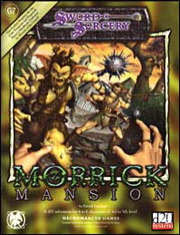
A Deadly Curse is Spreading! Morrick Mansion and the surrounding vineyards were deserted years ago when a terrible curse twisted every living thing on the property into a mockery of its prior form. Once whispered about and avoided, fear now grips the land. The curse spreads and someone needs to stop it. Can you find its source and cure it forever, or will the very curse you are investigating touch you with madness? Hatred, Death, and Danger! Morrick Mansion challenges adventurers to battle strange, mutant creatures in an effort to solve a mystery and stop an insidious curse. Do your players dare enter the mysterious mansion and can they survive long enough to discover the source of the curse?